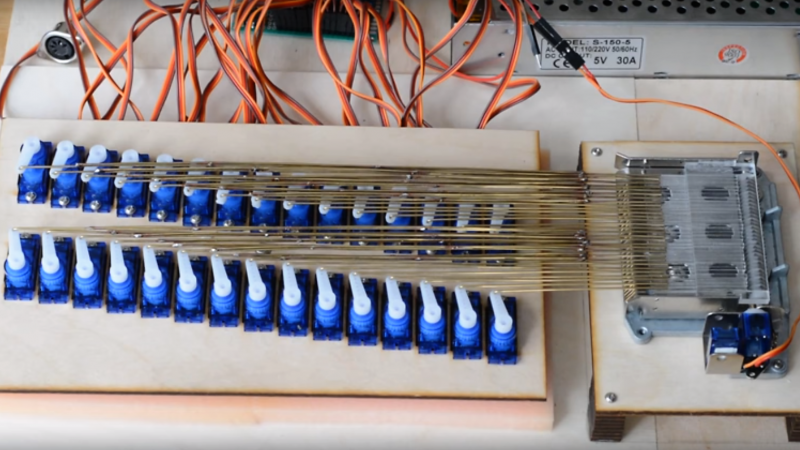It started with a cheap, punch-card programmable manual music box. Thirty-one hobby servos later, it ended as an automated MIDI music box, with a short pit stop as a keyboard-driven MIDI device.
If you think you’ve seen the music box in [Mitxela]’s video below before, you’re right. [Martin], musician, inventor, and father of the marvelous marble music machine, took an interest in these music boxes and their programming a while back. Like [Martin], [Mitxela] started his music box project with punch card programming, but he quickly grew tired of the bothersome process, even after automating production with a laser cutter. He decided to do away with the punch cards completely and devised a method to pluck all 30 notes using a few large handfuls of hobby servos. One servo, converted to continuous rotation, spins the drum, with the rest linked to small laser-cut acrylic plectrums via stiff brass wire. The fingers imitate the punched holes passing over the drum and pluck the notes according to MIDI messages. The whole thing can draw quite a bit of current, so in addition to a beefy power supply, [Mitxela] optimized the code to minimize power requirements. This had the happy consequence of reducing the latency enough to allow the music box to be played from a MIDI keyboard in real time.
A lot of work went into this one, but [Mitxela] isn’t resting on his laurels; he has a full slate of improvements that he wants to tackle, not least of which is SD card support for MIDI files to turn this into a jukebox. We’re looking forward to the updates.
Thanks to [HolyCrapCakes] for the tip.
















I wonder if it would have been better using solenoids, which already have a linear movement.
I’m currently working on project using servos to strike the keys on a glockenspiel. I did go through a solenoid phase, and I can tell you from painful experience, that no, it would not have been better to use solenoids.
What are the difficulties? I thought of it as well! But creating a good “strike”, you have to consider the relation of travel and force. Depending on the shape of the plunger, you get a mostly linear force, ore a in square to distance rising force.
Using solenoids for haptic feedback requires a lot of adjustment and planned actuation to get the right feeling.
OP mentions that he thought about solenoids but was worried about power management.
It worked well here: http://www.thebox.myzen.co.uk/Hardware/Glockenspiel.html
The main thing with that is the solenoid build is much more difficult, complex, and fiddly than a servo solution. You can see his diagram of what’s on the piston. That was much more work than necessary.
The solenoid also essentially firing a projectile at the glockenspiel plate. You can hear the sound in the audio file, there’s a bang part of the strike that’s not part of the note, and then the note itself is a tinny “plink”. The sound is dampened away by the continued motion of the piston almost before it starts. Compare the sound he’s getting from his mechanism to the sound you get just hitting the plate manually with the wooden hammer. The instrument should be producing a much richer and more sonorous sound than you can get by hitting it with a solenoid.
I believe this is why in the video he’s drowning out the sound of his actual glockenspiel with background music so it’s hard to hear his project. It just doesn’t sound good.
Also, I just want to add the music box this main article is about is a magnificent build, it’s gorgeous and sounds. looks and works amazingly good.
all solenoids
https://www.youtube.com/watch?v=VHaQR_7zf0o
That’s a very impressive setup, and thanks for posting the video, I did enjoy it. I’m also a fan of old-school calliopes which are all solenoid based.. What echodelta posted below is quite true as well.
But if you can’t understand why solenoids work there but are a poor choice for a diy midi glockenspiel from a cheap toy or for the midi music box presented here, I really don’t know what to say. For one thing, the machine in your video is mostly air pipes and some limited percussion. Comparing the elaborate machine in your video to tapping a resonator bell or music box comb is unfair to the machine in your video.
Oh well this is embarrassing, i read that title completely wrong.
This is wonderful. Fantastic. I adore it.
At first glance I was like Nope never, now I want to too.
Glad I watched the video. The picture had me envisioning a different action entirely. Cool build.
this is a very fun idea, great project!
Interesting to see twenty first century gear that uses such venerable ancient tech, particularly the escapement wheels. I wonder how many people pirated player rolls on the dining room table overlaying the latest hit tune on blank roll paper?
Every glockenspiel, chime etc. in theater pipe organs and those chimes behind the altar in church are solenoid driven unless air bellows struck. Deagan, Mass-Rowe all of them. To pluck anything use a harpsichord jack type of catch which is hinged to easily deflect on the return stroke. Computer drive of solenoids should be able to pulse at higher current to strike and much lower to hold if dampened on release as in chimes, glock’ etc. This is where you can lower the current draw. In a typical music box there is no damping, all notes are just plucked and sustain.
A small but fast and short timed solenoid could strike those tines and produce similar results. Electric pianos hammered tines to great effect.
Thats awesome! i love to seeing new music machines :)
That is beautiful, nice.
Only thing that bothers me is the brass rods not being straight(OCD i know).
Have you tried doing the drill trick to the rods?
Loving the choice of music!
Nice work. You inspire me.